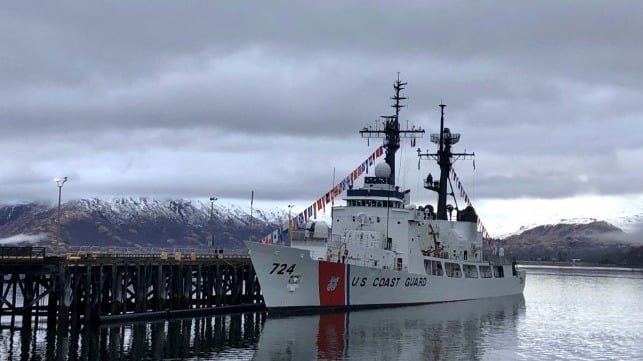U.S. Coast Guard Decommissions Last Hamilton-Class Cutter

On Saturday, the U.S. Coast Guard decommissioned the Hamilton-class high endurance cutter USCGC Douglas Munro in a ceremony at Coast Guard Base Kodiak, marking the end of an era. Munro was the last of her class in service, and she leaves behind a storied legacy.
The fleet of high endurance cutters has been replaced by the new 418-foot Legend-class national security cutters, which now serve as the Coast Guard’s primary long-range asset.
Commissioned in 1971, Munro was the tenth of twelve high endurance cutters built for long-range missions, including maritime security roles, drug interdiction, illegal migrant interception, fisheries patrols and high seas search and rescue.
The cutter was named after Signalman 1st Class Douglas Albert Munro, who was awarded the Medal of Honor for acts of heroism during World War II. Munro was the officer-in-charge of an eight-craft amphibious landing force during the Guadalcanal Campaign and used his landing craft and its .30 caliber machine gun to shield and protect several hundred Marines who were under heavy enemy fire. He was mortally wounded during this effort, but his actions allowed for the Marines to be extracted by other landing craft. Munro was posthumously awarded the Medal of Honor, making him the only person to receive the medal for actions performed during service in the Coast Guard.
“Today we say thank you and goodbye to the end of an era—an era of nearly 50 years when high endurance cutters took our service’s racing stripe around the globe, modeling the maritime rules-based order,” said Commandant Adm. Karl Schultz during the ceremony.
Over the past 49 years of service, Douglas Munro’s crews have served in a multitude of domestic and international theaters including the Bering Sea and Gulf of Alaska, Persian Gulf and Horn of Africa, and Southeast Asia and the Eastern Pacific.
In the early 1970s, the cutter served at Ocean Stations Delta, Bravo and November, providing weather data to trans-Pacific flights, supporting oceanographic research missions and performing search-and-rescue operations.
The crew of Douglas Munro also patrolled the Pacific for decades as an enforcer of fisheries regulations. In 1998, Douglas Munro’s crew discovered and seized over 11.5 tons of cocaine from a Mexican flagged vessel, the Xolesuientle, in what remains one of the largest single drug seizures in Coast Guard history. The following year, Douglas Munro’s crew seized the motor vessel Wing Fung Lung, which was attempting to transport 259 illegal Chinese migrants to the United States.
In early 2005, at the beginning of a six-month global circumnavigation that included support to Operations Iraqi Freedom and Enduring Freedom, the crew of Douglas Munro was diverted to render assistance to countries affected by an Indian Ocean tsunami.
In March 2008, the cutter’s crew and their embarked MH-65 helicopter worked with an Air Station Kodiak MH-60 helicopter crew to rescue 20 survivors from the fishing vessel Alaska Ranger, which sank in the Bering Sea. The 17th Coast Guard District commander at the time of the rescue, Rear Adm. Arthur Brooks, declared it "one of the greatest search and rescue efforts in modern history.”
"Serving as the final crew aboard the Coast Guard Cutter Douglas Munro, the last 378-foot cutter in the Coast Guard, has been an exciting and rewarding experience for myself and my shipmates," said Capt. Riley Gatewood, commanding officer of the Douglas Munro. "During my time aboard I have witnessed the sacrifices of the crew as they spent time away from their loved ones in service to their country. This dedication echoes the hard work put forth by our predecessors during the cutter’s 49-years of service and embodies the ship's motto, ‘Honoring the past by serving the present.’"
